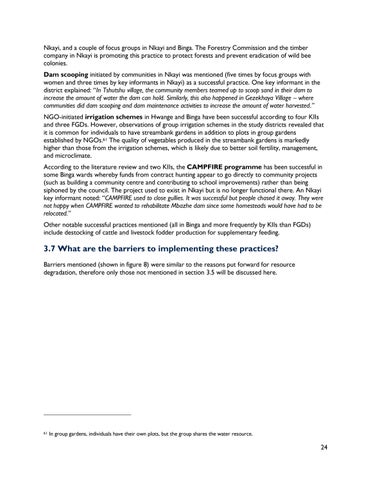Nkayi, and a couple of focus groups in Nkayi and Binga. The Forestry Commission and the timber company in Nkayi is promoting this practice to protect forests and prevent eradication of wild bee colonies. Dam scooping initiated by communities in Nkayi was mentioned (five times by focus groups with women and three times by key informants in Nkayi) as a successful practice. One key informant in the district explained: “In Tshutshu village, the community members teamed up to scoop sand in their dam to increase the amount of water the dam can hold. Similarly, this also happened in Gezekhaya Village – where communities did dam scooping and dam maintenance activities to increase the amount of water harvested.” NGO-initiated irrigation schemes in Hwange and Binga have been successful according to four KIIs and three FGDs. However, observations of group irrigation schemes in the study districts revealed that it is common for individuals to have streambank gardens in addition to plots in group gardens established by NGOs.61 The quality of vegetables produced in the streambank gardens is markedly higher than those from the irrigation schemes, which is likely due to better soil fertility, management, and microclimate. According to the literature review and two KIIs, the CAMPFIRE programme has been successful in some Binga wards whereby funds from contract hunting appear to go directly to community projects (such as building a community centre and contributing to school improvements) rather than being siphoned by the council. The project used to exist in Nkayi but is no longer functional there. An Nkayi key informant noted: “CAMPFIRE used to close gullies. It was successful but people chased it away. They were not happy when CAMPFIRE wanted to rehabilitate Mbazhe dam since some homesteads would have had to be relocated.” Other notable successful practices mentioned (all in Binga and more frequently by KIIs than FGDs) include destocking of cattle and livestock fodder production for supplementary feeding.
3.7 What are the barriers to implementing these practices? Barriers mentioned (shown in figure 8) were similar to the reasons put forward for resource degradation, therefore only those not mentioned in section 3.5 will be discussed here.
61
In group gardens, individuals have their own plots, but the group shares the water resource.
24

